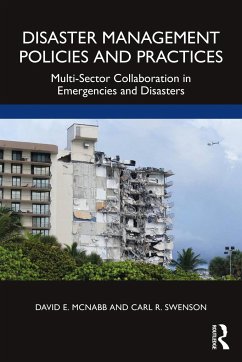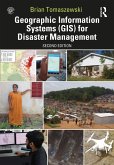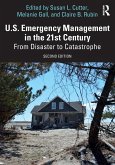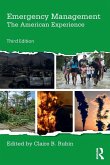David E. McNabb (Pacific Lutheran University, Tacoma, USA), Carl R. Swenson
Disaster Management Policies and Practices
Multi-Sector Collaboration in Emergencies and Disasters
David E. McNabb (Pacific Lutheran University, Tacoma, USA), Carl R. Swenson
Disaster Management Policies and Practices
Multi-Sector Collaboration in Emergencies and Disasters
- Broschiertes Buch
- Merkliste
- Auf die Merkliste
- Bewerten Bewerten
- Teilen
- Produkt teilen
- Produkterinnerung
- Produkterinnerung
In this book David E. McNabb and Carl R. Swenson blend their different experiences to outline the nature of the crises government leaders now face.
Andere Kunden interessierten sich auch für
![Geographic Information Systems (GIS) for Disaster Management Geographic Information Systems (GIS) for Disaster Management]() Brian TomaszewskiGeographic Information Systems (GIS) for Disaster Management132,99 €
Brian TomaszewskiGeographic Information Systems (GIS) for Disaster Management132,99 €![Towards Inclusive Social Policies? Towards Inclusive Social Policies?]() Diego Fossati (City University of Hong Kong)Towards Inclusive Social Policies?24,99 €
Diego Fossati (City University of Hong Kong)Towards Inclusive Social Policies?24,99 €![The Sociology of Disaster The Sociology of Disaster]() Thomas E. Drabek (USA University of Denver)The Sociology of Disaster49,99 €
Thomas E. Drabek (USA University of Denver)The Sociology of Disaster49,99 €![The Politics of European Security Policies The Politics of European Security Policies]() The Politics of European Security Policies58,99 €
The Politics of European Security Policies58,99 €![U.S. Emergency Management in the 21st Century U.S. Emergency Management in the 21st Century]() U.S. Emergency Management in the 21st Century86,99 €
U.S. Emergency Management in the 21st Century86,99 €![Emergency Management Emergency Management]() Emergency Management60,99 €
Emergency Management60,99 €![Leadership for Disaster Resilience Leadership for Disaster Resilience]() Jacquleen Joseph (India Tata Institute of Social Sciences)Leadership for Disaster Resilience52,99 €
Jacquleen Joseph (India Tata Institute of Social Sciences)Leadership for Disaster Resilience52,99 €-
-
-
In this book David E. McNabb and Carl R. Swenson blend their different experiences to outline the nature of the crises government leaders now face.
Produktdetails
- Produktdetails
- Verlag: Taylor & Francis Ltd
- Seitenzahl: 326
- Erscheinungstermin: 7. Oktober 2022
- Englisch
- Abmessung: 229mm x 152mm x 18mm
- Gewicht: 480g
- ISBN-13: 9781032315591
- ISBN-10: 1032315598
- Artikelnr.: 64358835
- Herstellerkennzeichnung
- Libri GmbH
- Europaallee 1
- 36244 Bad Hersfeld
- gpsr@libri.de
- Verlag: Taylor & Francis Ltd
- Seitenzahl: 326
- Erscheinungstermin: 7. Oktober 2022
- Englisch
- Abmessung: 229mm x 152mm x 18mm
- Gewicht: 480g
- ISBN-13: 9781032315591
- ISBN-10: 1032315598
- Artikelnr.: 64358835
- Herstellerkennzeichnung
- Libri GmbH
- Europaallee 1
- 36244 Bad Hersfeld
- gpsr@libri.de
David E. McNabb is Professor Emeritus at the Pacific Lutheran University School of Business, USA. He has taught undergraduate and graduate business and administration courses for the University of Maryland-University College, the American University in Bulgaria, the Stockholm School of Economics in Riga, Latvia, and the MPA program at Evergreen State College, Olympia, Washington. Carl R. Swenson has 35 years of experience managing cities in Arizona, Illinois, and Washington. He is a life member of the International City/County Management Association (ICMA) and is recognized as a credentialed city manager (retired), and a legacy leader in professional city and county management.
1. Nature of Emergency Management 2. Emergency Management Framework 3.
Collaborative Disaster Governance 4. Disaster Response Models 5. Hazard
Mitigation and Remediation 6. Emergency Project Management Framework 7.
Emergency Management Responsibilities 8. Collaborative Emergency Management
9. Nongovernment Partnerships 10. Emergency and Disaster Partnerships 11.
Supporting Community Lifelines 12. Sustaining Social and Economic
Continuity 13. Managing a Pandemic Disaster 14. Wildfire Disaster
Governance 15. Windstorm-Driven Disaster Governance 16. Flood Disaster
Governance 17. Infrastructure and Housing Emergency Governance 18.
Conclusion: Preparing for Future Disasters Afterword Appendix A:
Classification of Potential Hazards Appendix B: Descriptions of Plausible
FEMA Operations Appendix C: Definitions of Standardized Incident Impacts
Appendix D: National Incident Management System Excerpts Appendix E:
Suggested Emergency Response Preparedness Checklist Items
Collaborative Disaster Governance 4. Disaster Response Models 5. Hazard
Mitigation and Remediation 6. Emergency Project Management Framework 7.
Emergency Management Responsibilities 8. Collaborative Emergency Management
9. Nongovernment Partnerships 10. Emergency and Disaster Partnerships 11.
Supporting Community Lifelines 12. Sustaining Social and Economic
Continuity 13. Managing a Pandemic Disaster 14. Wildfire Disaster
Governance 15. Windstorm-Driven Disaster Governance 16. Flood Disaster
Governance 17. Infrastructure and Housing Emergency Governance 18.
Conclusion: Preparing for Future Disasters Afterword Appendix A:
Classification of Potential Hazards Appendix B: Descriptions of Plausible
FEMA Operations Appendix C: Definitions of Standardized Incident Impacts
Appendix D: National Incident Management System Excerpts Appendix E:
Suggested Emergency Response Preparedness Checklist Items
1. Nature of Emergency Management 2. Emergency Management Framework 3.
Collaborative Disaster Governance 4. Disaster Response Models 5. Hazard
Mitigation and Remediation 6. Emergency Project Management Framework 7.
Emergency Management Responsibilities 8. Collaborative Emergency Management
9. Nongovernment Partnerships 10. Emergency and Disaster Partnerships 11.
Supporting Community Lifelines 12. Sustaining Social and Economic
Continuity 13. Managing a Pandemic Disaster 14. Wildfire Disaster
Governance 15. Windstorm-Driven Disaster Governance 16. Flood Disaster
Governance 17. Infrastructure and Housing Emergency Governance 18.
Conclusion: Preparing for Future Disasters Afterword Appendix A:
Classification of Potential Hazards Appendix B: Descriptions of Plausible
FEMA Operations Appendix C: Definitions of Standardized Incident Impacts
Appendix D: National Incident Management System Excerpts Appendix E:
Suggested Emergency Response Preparedness Checklist Items
Collaborative Disaster Governance 4. Disaster Response Models 5. Hazard
Mitigation and Remediation 6. Emergency Project Management Framework 7.
Emergency Management Responsibilities 8. Collaborative Emergency Management
9. Nongovernment Partnerships 10. Emergency and Disaster Partnerships 11.
Supporting Community Lifelines 12. Sustaining Social and Economic
Continuity 13. Managing a Pandemic Disaster 14. Wildfire Disaster
Governance 15. Windstorm-Driven Disaster Governance 16. Flood Disaster
Governance 17. Infrastructure and Housing Emergency Governance 18.
Conclusion: Preparing for Future Disasters Afterword Appendix A:
Classification of Potential Hazards Appendix B: Descriptions of Plausible
FEMA Operations Appendix C: Definitions of Standardized Incident Impacts
Appendix D: National Incident Management System Excerpts Appendix E:
Suggested Emergency Response Preparedness Checklist Items









